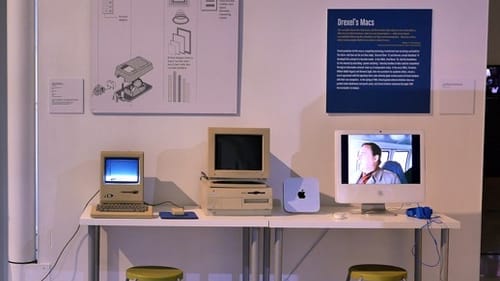Stay in the Loop
BSR publishes on a weekly schedule, with an email newsletter every Wednesday and Thursday morning. There’s no paywall, and subscribing is always free.
More than a retrospective
Drexel University's Westphal College presents 125 Years: Drexel & the City

A black-and-white aerial photograph of West Philadelphia is the signature image of 125 Years: Drexel & the City, an exhibit marking the growth of the university and West Philadelphia since Drexel’s 1891 founding. That might make you expect the installation in the Leonard Pearlstein Gallery to be just a ho-hum stroll down memory lane. It definitely is not.
The Pearlstein gallery has been transformed into a kaleidoscope of past, present, and future, displaying the things for which Drexel is known -- art, science, and industry -- through artifacts, film, and immersive experiences. A miniature map of the campus has been laid out on the gallery floors, with lines representing Market, Chestnut, Walnut, Lancaster, and Powelton. Life-size models of a typical West Philly porch and front stoop provide space for forums and presentations. A clothesline of takeaway conversation starters invites visitors to contribute their own comments and memories.
Transportation key to past, future
An animated time-lapse film designed by Drexel alum Nick Jushchyshyn and a team of four students transports viewers from 1895 to the present, looking east toward City Hall. In seconds, the landscape transforms from industrial flatlands into 21st-century corridors and towers. Two constants are the row-home residential areas bordering the campus and train tracks crisscrossing the neighborhood.
The importance of public transportation in Drexel’s development is made clear. Home movies of Philadelphia Transportation Company (PTC) trolleys in 1956 and 1961 signify the convenience they provided students. Though it has grown beyond those commuter-school roots, its proximity to 30th Street Station, the third-busiest train station in the United States, is key as Drexel embarks on the establishment of Schuylkill Yards. The project is a 21st-century iteration of founder Anthony J. Drexel’s vision of an institution dedicated to achieving innovation through the study of art, science, and industry. In a video, current Drexel president John Fry explains that Schuylkill Yards will be a community encompassing innovation in education, medicine, culture, business, and residential life on the banks of the Schuylkill River.
History meets high-tech
City maps from the time of Drexel Institute’s founding, aided by a period soundscape of blacksmiths hammering anvils, trains whistling, and even cattle, draw a vastly different picture. Drexel took root in a heavily industrial area, a rail hub dotted with iron foundries, grain elevators, coal yards, freight storage, and stockyards. Long-gone public institutions for the elderly, ill, and indigent were also in the tract, with antiquated names such as Old Men’s Home, Old Ladies' Home, Children’s Home, Blockley Alms House, and Pennsylvania Hospital for the Insane. A 1924 photograph taken by William Nicholson Jennings at 22nd and Arch Streets shows a smoky, largely unrecognizable panorama. Only the Schuylkill River is identifiable.

More familiar are the residential set pieces: a 1950s-style porch and front steps typical of Powelton and Mantua homes. Though old-fashioned in appearance, the porch was fabricated at Drexel with technologies unimaginable in its heyday, including a computerized router and 3D printer.
Contributions from the Hybrid Lab and Fashion Design program similarly connect past to present and future. Dresses designed with traditional skills -- hand-drawn sketches, sewn fabrics, and patternmaking -- are rendered with new methods, such as digitally printed fabrics, laser cutting, and 3D printing.
Artificial intelligence, synthetic life
The most fascinating and advanced installation is a film loop depicting a “habitat for non-humanity,” from the Design Futures Lab. It features NESL – Nurturing Emergent Synthetic Life -- and demonstrates a dynamic environment that supports the growth of mineral-based crystals and is inhabited by robotic creatures. The film shows the interaction among changing terrain, robots, and crystals, which flourish in shapes and colors to equal any botanical garden. It is a mesmerizing and surreal take on the future.
Past is prologue
Those born into a world in which computers are as common as telephones may not understand the significance of the boxy beige Apple 128K microcomputers that sit quietly on a table. Now looking as ancient as ENIAC, the Apple desktops were revolutionary in 1985, when Drexel provided each student with a personal computer, freeing them from typing countless punch cards to run on the university mainframe. At the time, computers in offices -- where they existed -- were mostly shared, and it was a rare home that contained a desktop. So those little pyramids of personal computing, so forward-looking in their day, symbolize the perspective that has propelled Drexel ever since you could stand at 32nd and Chestnut Streets and hear the cattle moo.
What, When, Where
125 Years: Drexel & The City. Through March 19, 2017, at the Leonard Pearlstein Gallery, URBN Annex, 3401 Filbert Street, Philadelphia. (215) 895-2000 or drexel.edu/pearlsteingallery.
Sign up for our newsletter
All of the week's new articles, all in one place. Sign up for the free weekly BSR newsletters, and don't miss a conversation.
